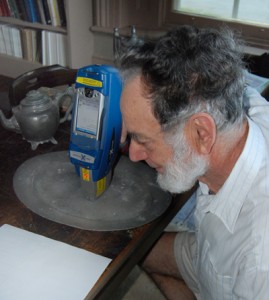RESEARCHING OUR COLLECTION:
SORTING OUT THE PAST USING X-RAYS: 2008
 In our files we have a note about a water jug we know little about. The note reads, “possibly pewter or aluminum”. Many 19th-century metal wares were produced cheaply and sold unmarked, so there are no markings to guide us. We have many such “mystery” pieces in the museum; unmarked and of unknown origin but potential gems everyone.
In our files we have a note about a water jug we know little about. The note reads, “possibly pewter or aluminum”. Many 19th-century metal wares were produced cheaply and sold unmarked, so there are no markings to guide us. We have many such “mystery” pieces in the museum; unmarked and of unknown origin but potential gems everyone.
To help the UEL Museum sort out its collection of “white metal” artifacts, we approached Prof. Herbert Shurvell, a chemist with the Art Conservation Program at Queen’s University in Kingston, Ontario. Last Friday afternoon was hot and humid when Gus lugged his large black case up the steps of the museum in Adolphustown. Inside the case was the University’s recently purchased X-Ray Fluorescence (XRF) device. Gus just happens to be one of two people licensed to use it. With XRF technology we can very quickly analyze the elemental composition of artifacts. Point the device at a pewter water jug, press a button like you’re taking a picture with a camera. And voila! Pewter is no longer just pewter; it is a mixture of other metals; maybe 85% tin and 5% lead, or 95% tin and 1% copper.
These details about what artifacts are made of is vital to understanding the culture that produced and used them. Understanding the details of the culture that produced and used artifacts also helps to identify where a piece of history comes from. For example, pewter made in England from the 15th century onwards was strictly controlled. It was divided into three grades all based on the content of tin and the presence of certain metals like copper and lead, with the highest quality having the most tin content. Gus’s XRF gun will instantly tell us how much tin, copper and lead is in any artifact we want.
The two objects at the UEL museum that we were most interested in were a large platter and that water jug. They are both gray and dull to look at, but the water jug is much lighter in weight and colour. It does not have the weight of pewter, but its style and condition suggested it might be quite old.
Gus pointed the XRF gun at the jug, and within seconds we knew it was not pewter, but aluminum. Aluminum has not been in common usage for very long. Conclusion: the jug could be no older than 1890. The platter, on the other hand, turned out to be 95% tin, 1% copper, and the rest lead; an ideal recipe in the 18th century for a fine quality pewter. We still don’t know the exact date yet, but a platter made after 1800 would more likely be stamped from sheet material, and ours looks to have been cast in a mold.
It is quite possible this rumored Loyalist artifact may prove to be the real thing. Now all we need to do is find some spare time to do the extra research to find out for sure…
